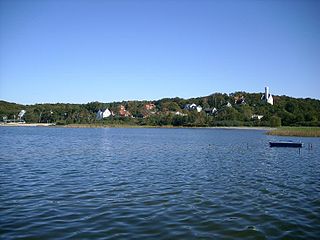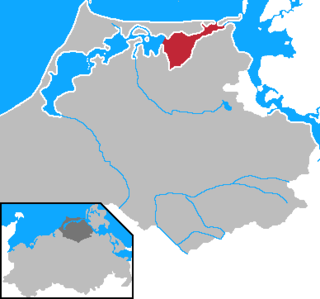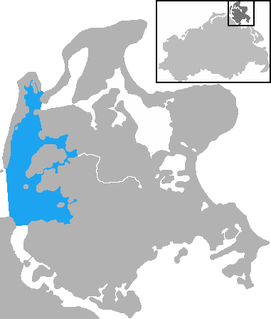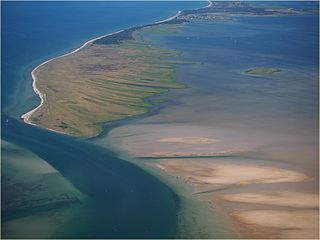
The Western Pomerania Lagoon Area National Park is Mecklenburg-Vorpommern's largest national park, situated at the coast of the Baltic Sea. It consists of several peninsulas, islands and lagoon shore areas in the Baltic Sea, belonging to the district of Vorpommern-Rügen.

Hiddensee is a car-free island in the Baltic Sea, located west of Germany's largest island, Rügen, on the German coast.

Zingst is the easternmost portion of the three-part Fischland-Darß-Zingst Peninsula, located in Mecklenburg-Vorpommern, Germany, between the cities of Rostock and Stralsund on the southern shore of the Baltic Sea.

The island of Ummanz lies in the Baltic Sea, off the west coast of the island of Rügen, and belongs, like the latter, to the county of Vorpommern-Rügen in the German state of Mecklenburg-Western Pomerania.

Fischland-Darß-Zingst or Fischland-Darss-Zingst is a 45 km (28 mi) long peninsula in the coastal district of Vorpommern-Rügen, in the German state of Mecklenburg-Vorpommern. The three parts of the peninsula, from west to east, are Fischland, Darß and Zingst.

Bodden are briny bodies of water often forming lagoons, along the southwestern shores of the Baltic Sea, primarily in Germany's state of Mecklenburg-Vorpommern. These lagoons can be found especially around the island of Rügen, Usedom and the Fischland-Darss-Zingst peninsula. Some of them are protected reserves, forming the Western Pomerania Lagoon Area National Park.

The Darss-Zingst Bodden Chain is a waterbody on the Baltic Sea coast northeast of Rostock in Germany. It consists of a string of several lagoons or bodden arranged in an east-west direction that are separated from the open sea by the Fischland-Darß-Zingst peninsula. The surface area of these lagoons is 197 km² and the average water depth is only about two metres.

The Großer Jasmunder Bodden belongs to the Northern Rügener Boddens and is a water body on the southern edge of the Baltic Sea in the German state of Mecklenburg-Vorpommern. It is a bodden, a type of lagoon that occurs in northern Europe especially on the coast of Pomerania. It lies within the island of Rügen, is around 14 kilometres long, an average of six kilometres wide and is up to nine metres deep with an average depth of 5.3m. The Großer Jasmunder Bodden has an area of 58.6 square kilometres; if the Breetzer Bodden, Breeger Bodden, Lebbiner Bodden, Neuendorfer Wiek and Tetzitzer See are included the total area of water comes to over 94 square kilometres.

The Kleiner Jasmunder Bodden belongs to the North Rügen Bodden and is a water body on the southern edge of the Baltic Sea in the German state of Mecklenburg-Vorpommern. It is a bodden, a type of lagoon that occurs in northern Europe especially on the coast of Pomerania. It is around seven kilometres long and five kilometres across at its widest point, but in places it is considerably narrower. It has an area of 28.4 square kilometres.

The Schaproder Bodden is a bodden on the Baltic Sea coast between the island of Hiddensee in the west and the islands of Rügen and Ummanz in the east. To the north the Schaproder Bodden is linked to the Vitter Bodden by the so-called Trog between the Fährinsel and the Stolper Haken of Rügen island. To the south the bodden transitions into the Kubitzer Bodden. A boundary would be the line between the southern tips of the Hiddensee and Ummanz or the link from the Geller Haken - Insel Heuwiese.

The Grabow is a bodden - a lagoon-like waterbody - off the Baltic Sea south of the Zingst and Großer Werder peninsulas and the island group of Kleiner Werder.

The West Rügen Bodden are a string of lagoons and embayments, known as bodden, in Western Pomerania on the Baltic Sea coast. They lie in the Western Pomerania Lagoon Area National Park west and southwest of the island of Rügen, and east and southeast of Hiddensee.

The Udarser Wiek is a bay on Germany's Baltic Sea coast, about 8 km² in area, between the islands of Rügen in the north and Ummanz in the south. In the west, the bodden transitions into the Schaproder Bodden and in the southeast to the Gahlitz in the lake of Koselower See. At the northeast end of the bay lies the island of Öhe.

The tiny uninhabited German island of Gänsewerder lies in the Schaproder Bodden, a lagoon on the Baltic Sea coast, 400 metres east of the Gellen Peninsula on Hiddensee. It is part of the Western Pomerania Lagoon Area National Park and is out of bounds to the public. The surface of Gänsewerder is flat, sandy and damp, and only reeds and small plants grow there. There is a small pond in the northeast of the island. The island has an oval shape and slopes along its longer axis from southwest to northeast. It measures about 328 by 155 metres and has an area of some 4 hectares. When the national park was established, Gänsewerder was a coastal nesting area for birds, but is no longer. The island of Fährinsel off Hiddensee, which is inhabited by several species of bird, is managed as one area along with the Gellen and Gänserwerder.

The Vitter Bodden is a type of lagoon called a bodden between the northern part of the island of Hiddensee to the west and north and the peninsula of Bug, the Wieker Bodden and the northern part of the Schaprode peninsula to the east. In the north the bodden borders on the Bay of Libben on the open Baltic Sea and in the south on the Schaproder Bodden. It is one of the West Rügen Bodden.

The Kubitzer Bodden is a type of lagoon known as a bodden on the Baltic Sea coast in the southwestern area of the island of Rügen in Germany. In the north the bodden is bounded by the Lieschow peninsula on Rügen. In the east and south the shores of the island of Rügen near Dreschvitz, Samtens and Rambin form its natural perimeter. The boundary with the Strelasund to the west is the line between the hook known as the Bessiner Haken near Bessin in the south and the tip of the Lieschow peninsula in the north.

The Prerower Strom, Prerow Strom or Prerowstrom is an arm of the Baltic Sea in northeast Germany. It begins near the island of Schmidtbülten in the Bodstedter Bodden and winds its way through the countryside of the peninsula of Fischland-Darß-Zingst, where it separates Darß from the peninsula of Zingst. It ends at the harbour of the village of Prerow that gives it its name. The Prerower Strom is part of the Western Pomerania Lagoon Area National Park.

A gat is a strait that is constantly eroded by currents flowing back and forth, such as tidal currents. It is usually a relatively narrow but deep, up to 30 m (100 ft) passage between land masses or shallow bars in an area of mudflats. A gat is sometimes a shallower passage on lagoon coasts, including those without any tidal range.

Kleiner Werder is the name of an island and its associated group of uninhabited and not clearly geographically separable German islands in the Baltic Sea that belong to the state of Mecklenburg-Western Pomerania.

The island of Bock lies in the Baltic Sea southwest of the island of Hiddensee and east of the peninsula of Zingst. It belongs to the municipality of Groß Mohrdorf in the northeast German state of Mecklenburg-Vorpommern.























